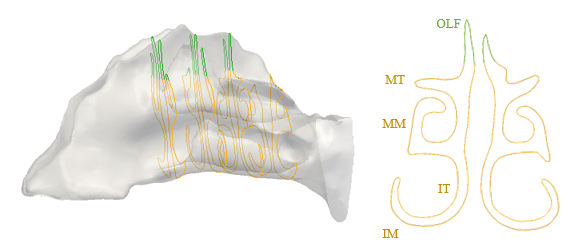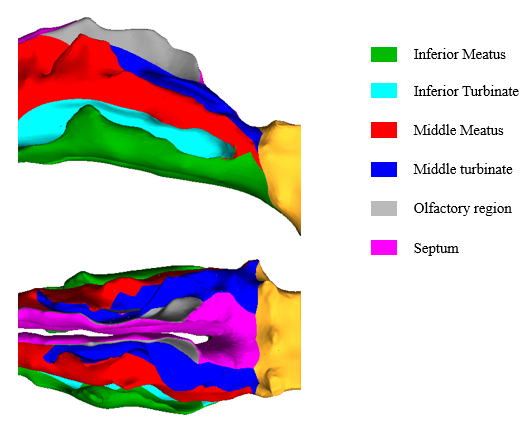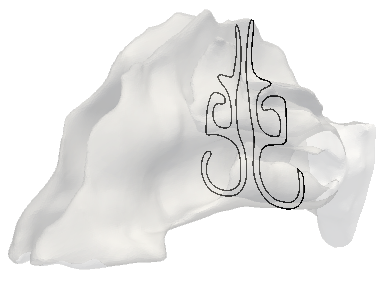How computational analysis of a 3D mucociliary clearance model can help predict drug uptake and lead to more generic nasal drug products
In 2020, CDER’s Office of Generic Drugs (OGD) and several partner researchers quantified the effect of drug solubility and partition coefficient on the dissolution and subsequent uptake of drugs in a realistic nasal cavity model. The results provided insight into the possible effects of formulation variables such as solubility, partition coefficient, and particle size on systemic exposure inside the nasal cavity. Complex locally-acting generic drug products, such as some orally inhaled or nasal drug products, can be more challenging for generic drug developers to copy, often leading to a lack of generic competition even after patents and exclusivities no longer block generic drug approval. Accurate and realistic predictions from computer simulations about deposition and absorption of nasally inhaled drugs can provide a deeper understanding of complex fluid-particle dynamics in the nasal cavity which may help OGD clarify regulatory expectations early in the drug development process and during application assessment.
While most nasal drug products target local drug delivery to nasal tissues, there is an interest within industry for developing products that target blood-brain barrier (BBB) for rapid delivery to the central nervous system (Pardeshi et al., 2013). As nasal drug products with BBB targeting enter the market, there will be a need for understanding how to assess bioequivalence for proposed generic versions of these products. Currently available models for predicting drug deposition and absorption of nasal drug products such as the model developed by Rygg et al. (2016) have shown promise but are incapable of accurately predicting local absorption. To facilitate accurate local nasal deposition predictions, a three-dimensional (3D) model using computational fluid dynamics (CFD) was developed for this study that includes a paired mucus layer model.
Determining How to Enhance Drug Uptake through Clearance, Dissolution, and Absorption
The noninvasive nature of intranasal drug administration makes it a widely adopted technique for local and systemic delivery of therapeutic agents. The nasal mucosa, unlike other mucosae, is easily accessible. Intranasal application circumvents the issues of gastrointestinal degradation and hepatic first pass metabolism of the drug (Bitter et al., 2011).
However, drugs intended to hit a target site within the nasal cavity are also trapped in the highly viscous gel layer reducing the efficacy of the drug. Soluble drugs, however, dissolve in the mucus layer, diffuse across the gel and sol layers, and are eventually absorbed by the richly vascularized nasal epithelium. This enables a drug to enter the systemic regions through the blood stream without losing efficacy.
A computational 3D mucociliary clearance (MCC) model was developed for this study, with the goal of realistically quantifying the effects of drug solubility and partition coefficient on the dissolution and subsequent uptake of drugs in the nasal cavity to achieve a desired therapeutic effect. The results of the study provide insight into the effects of formulation variables like solubility and partition coefficient on systemic exposure inside the nasal cavity. The goal is to eventually enhance drug uptake through a combination of clearance, dissolution, and absorption, as well as drug targeting, to maximize drug uptake.
Methods
The open-source CFD flow solver toolbox, OpenFOAM version 1706 (www.openfoam.com), was employed for the development of the computer simulation model. As part of the design, a novel 3D meshing technique allows the model to smoothly capture the relatively large flow domain as well as the micron-size mucus layer. This efficient meshing strategy drastically reduces the overall meshing time from hours to a matter of minutes. Segmental concentration contours as a visualization tool explain regional trends in cumulative drug uptake.
The effects of pharmacokinetic characteristics of hypothetical drugs on the dissolution, subsequent uptake, and clearance were analyzed. A method to impose boundary-driven flow velocity that mimics the beating of the cilia was introduced. Rather than selecting specific drugs, the model was supplied with ranges of parameters that provide a general understanding of how drugs are absorbed in the nasal cavity. Several drug specific parameters, such as solubility, partition coefficient, and particle size, were considered. The effects of particle distribution on MCC and uptake were simulated as well.
Velocity Profiles
To validate the accuracy of the velocity field obtained from the proposed 3D mucus model, inert particle clearance data from the nose obtained from simulations was compared with in vivo data reported by Shah et al. (2015). In this in vivo study, radiolabel tracers were injected as nasal sprays, which deposited on the walls of the nasal cavities. After 15 minutes, they found that 60% of the tracers were removed, consistent with other studies (Naclerio et al., 2003; Bacon et al., 2010) that reported a similar removal percentage. Since the administered radiolabel tracers were not absorbed, they concluded that this removal must be from MCC, confirming deposition to the ciliated posterior regions beyond the nasal valve.
The initial positions of the tracers reported by Shah et al. (2015) were used to define the initial positions of inert particles for simulations conducted in this study. About 60% of the inert particles were injected from the posterior, ciliated region and 40% were introduced from the non-ciliated NV region. A transient simulation tracking the trajectory of these inert particles was then run for a duration of 6 hours, consistent with the in vivo study.
The mass remaining in the computational domain was calculated and compared with the value reported in the in vivo study. The computational values compare well with those observed in the experimental study. Based on this evidence, it can be concluded that the velocity field obtained from the CFD model is expected to accurately represent MCC, including the effects of local changes in the velocity profile required to maintain a constant ASL thickness.
Velocity magnitude is computed at several slices by dividing each slice into the major nasal segments (inferior meatus (IM), inferior turbinate (IT), middle meatus (MM), middle turbinate (MT), olfactory region (OLF)). Each segment is then divided into several evenly spaced subdivisions and the average velocity is calculated at each segment of the slice (see Figure 1).
Figure 1: Mucus layer is divided into several slices. Left - Each slice is subdivided into a number of segments: inferior meatus (IM), inferior turbinate (IT), middle meatus (MM), middle turbinate (MT) & olfactory region (OLF).
For visualization of the simulation results, the nasal cavity model was divided into three main regions: the anterior nasal vestibule (NV) which is unciliated, the middle passages (MPs), and the posterior nasopharynx. The MPs are further subdivided into different anatomical regions viz. IM, IT, MM, MT, OLF, and the septum (see Figure 2).
Figure 2: Middle passages (MP) divided into seven segmental regions
The drug concentration and uptake in the subsequent sections were analyzed at a slice taken at approximately 50 mm from the nostril (Figure 3). This slice has a large cross section area which make it relatively easier to study trends in the concentration and uptake profiles across the thickness of the mucus layer. In addition, this slice is positioned in such a way that all seven sections of the MP detailed above are encapsulated. Its location closer to the nasopharynx helps in accounting for particles that might escape or get swallowed which otherwise would be difficult to estimate on a slice closer to NV.
Figure 3: Position of the slice (50mm from the nostrils)
Findings Highlights
Increasing the oil-in-water partition coefficient (Ko/w) from 5e-3 to 2 resulted in faster uptake of the dissolved drug in the epithelium. This relatively quicker uptake suggests that drugs with a higher value of Ko/w are more effective when targeting proximal regions in the nasal cavity. On the other hand, decreasing the partition coefficient of a drug leads to increased absorption in the posterior regions of the nasal cavity. However, reducing the partition coefficient drastically can lead to a large amount of drug being swallowed by the patient, which may then be absorbed through the gastrointestinal tract. Thus, based on the intended target site in the mucus layer, drugs with either high or low partition coefficients may be preferred.
Particle size is another aspect that influences drug uptake in the epithelium. We compared two different particle sizes (3 µm and 5 µm) and studied their effect on drug uptake in the epithelium. The 3 µm particles dissolved faster than the 5 µm particles and consequently were more readily available for uptake. Also, the larger particles deposited more in the anterior third of the nasal cavity, which is predominantly lined with squamous epithelium, due to inertial impaction. For these particles to be absorbed, the dissolved drug must reach the posterior part of the nasal cavity which is ciliated and lined with columnar epithelial cells.
Drug solubility also plays an important role on a drug’s subsequent uptake. As solubility increases, the rate of dissolution and subsequent uptake of the drug also increase. Two different drug solubility values (0.02 mg/ml and 0.2 mg/ml) were considered as model inputs. It was observed that the cumulative uptake for the 0.2 mg/ml drug was appreciably higher than the drug with a 0.02 mg/ml solubility. Typically, drugs with higher solubility tend to dissolve completely. This ensures a higher uptake in the epithelium, but it also makes it difficult for the drug to reach the distal regions of the nasal cavity.
Finally, the effect of initial particle deposition location on cumulative drug uptake was studied. Particle deposition trends in the nasal cavity depend on the initial particle size. Larger particles tend to deposit more in the anterior third of the nasal cavity owing to inertial impaction whereas smaller particles (< 5 µm) show a more distributed spread in their initial deposition. Thus, if the goal is to achieve a high uptake rate, smaller sized particles must be selected at the drug formulation stage. Based on these observations, a number of drug formulation parameters can be tweaked to attain the desired rate of uptake.
The present results indicate that drug deposition in the unciliated anterior third of the nose precludes active translocation of these drugs to the posterior, distal regions via MCC. Thus, present nasal drug delivery mechanisms may benefit from modification. One potential modification may be to combine current bio-adhesive approaches with targeted drug delivery to pre-determined sites in the nasal cavities.
Although the current CFD model lays a solid foundation for drug uptake predictions through the intranasal route, it has certain limitations. The airway surface layer (ASL) in this study consists of a gel layer and a sol layer. The gel layer is modeled as a Newtonian fluid with a high viscosity compared to the sol layer whose viscosity is 10,000 times lower than that in the gel layer. Although the gel layer may exhibit rheological complexities, a Newtonian approximation can be assumed as the local shear rates are relatively small.
Future Work
The model in its current form calculates the cumulative mass of the dissolved drug that is absorbed at the epithelium but does not calculate the plasma concentration profiles. This makes it difficult to fully assess the efficacy of the drug due to MCC in the different systemic regions. To address this limitation, a physiologically-based pharmacokinetics (PBPK) model is planned to simulate the amount of drug that enters both the epithelial cells and the systemic circulation. It will allow for a one-to-one comparison of nasal deposition profiles and blood concentration of the inhaled drugs.
This Impact Story is based on the work of Sriram Chari, Karthik Sridhar, Ross Walenga, Clement Kleinstreuer, “Computational analysis of a 3D mucociliary clearance model predicting nasal drug uptake,” in the Journal of Aerosol Science, Volume 155, 2021, https://doi.org/10.1016/j.jaerosci.2021.105757
How does this work advance drug development?
The mucociliary clearance model developed by CDER and its research partners can help us to rationally predict the effects of changes in the properties of nasally delivered drug candidates on drug exposures in patients. This capability can aid in the development of new safe and effective nasally inhaled drugs as well as generics of these complex products.
References
- Bacon R, Newman S, Rankin L, Pitcairn G, Whiting R. 2012. Pulmonary and nasal deposition of ketorolac tromethamine solution (SPRIX) following intranasal administration. International journal of pharmaceutics 431(1-2):39-44.
- Bitter C, Suter-Zimmermann K, Surber C. 2011. Nasal drug delivery in humans. Karger Publishers, Topical Applications and the Mucosa; p. 20-35.
- Blake J. 1972. A model for the micro-structure in ciliated organisms. Journal of Fluid Mechanics 55(1):1-23.
- Fulford GR, Blake JR. 1986. Muco-ciliary transport in the lung. Journal of theoretical biology 121(4):381-402.
- Funk JR, Hall GW, Crandall JR, Pilkey WD. 2000. Linear and quasi-linear viscoelastic characterization of ankle ligaments. Journal of Biomechanical Engineering 122(1):15-22.
- King M, Agarwal M, Shukla JB. 1993. A planar model for mucociliary transport: effect of mucus viscoelasticity. Biorheology 30(1):49-61.
- Naclerio RM, Baroody FM, Bidani N, Marcy De T, Penney BC. 2003. A comparison of nasal clearance after treatment of perennial allergic rhinitis with budesonide and mometasone. Otolaryngology Head and Neck Surgery 128(2):220-227.
- Pardeshi CV, Belgamwar VS. 2013. Direct nose to brain drug delivery via integrated nerve pathways bypassing the blood–brain barrier: an excellent platform for brain targeting. Expert opinion on drug delivery 10(7):957-72.
- Sedaghat MH, Shahmardan MM, Norouzi M, Nazari M, Jayathilake PG. 2016. On the effect of mucus rheology on the muco-ciliary transport. Mathematical biosciences 272:44-53.
- Shah SA, Berger RL, McDermott J, Gupta P, Monteith D, Connor A, Lin W, editors. 2015. Regional deposition of mometasone furoate nasal spray suspension in humans. Allergy & Asthma Proceedings.
- Sleigh MA, Blake JR, Liron N. 1988. The propulsion of mucus by cilia. American Review of Respiratory Disease 137(3):726-741.
- Smith DJ, Gaffney EA, Blake JR. 2008. Modelling mucociliary clearance. Respiratory physiology & neurobiology 163(1-3):178-188.



